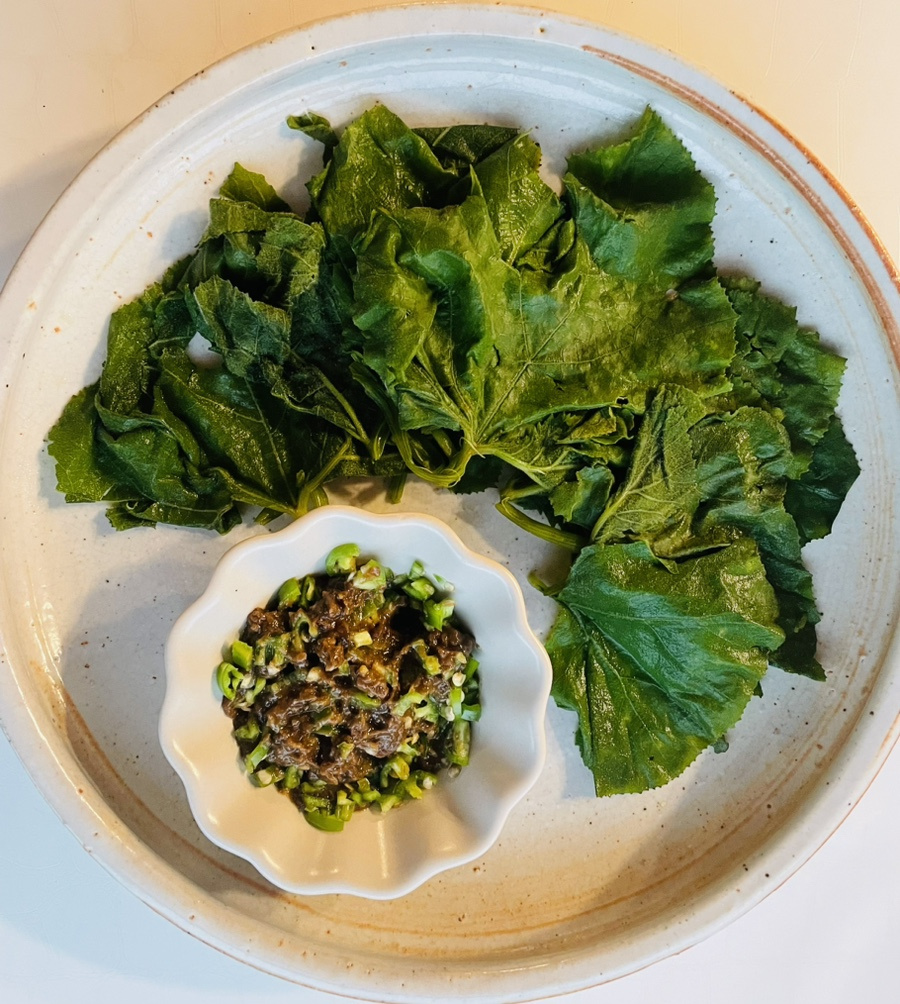Fragrant Steamed Zucchini Leaves with Low-Sodium Ssamjang
Seasonal Zucchini Leaves: A Healthy Recipe for Steaming and Enjoying

I never knew zucchini leaves were edible until I saw them at my in-laws’ house when I was younger. This year, I realized I hadn’t steamed any zucchini leaves yet! My husband mentioned he wanted some, so I bought a basketful from the market. Wild zucchini leaves, which grow in fields, freeze and become inedible after the first frost, and then greenhouse-grown ones usually appear. Since I bought these towards the end of the season, I feel like this might be my first and almost last chance to enjoy them this year. Zucchini leaves have a somewhat rough texture, but when steamed, they become incredibly tender. However, it’s important to peel off the tough fibrous outer layer. You can easily pull off the long, thread-like fibers by gently pinching and pulling from the end of the zucchini stem. Since the fine hairs on zucchini leaves can cause allergic reactions (I get hives if I touch them with bare hands, sadly), it’s best to wear rubber or plastic gloves when handling them. Zucchini leaves need to be steamed generously to enjoy them as soft wraps. I steamed them for about 20 minutes over medium-high heat until they were thoroughly tender. Paired with a low-sodium ssamjang, a bowl of rice disappears in no time! Although they are common in the summer and I’m a bit sad to be eating them at the end of the season, I’m comforted knowing I didn’t miss out on this year’s zucchini leaves. The steamed zucchini leaves, retaining their vibrant green color, are tender and soft, looking appetizing enough to whet your appetite. Besides enjoying them as wraps, steamed zucchini leaves are also delicious added to doenjang jjigae (fermented soybean paste stew). If you have leftover steamed zucchini wraps, adding them towards the end of boiling doenjang stew creates a unique delicacy. They are also delicious when added to fish stews. The unique aroma and texture of zucchini leaves make for a comforting dish. Eating seasonal foods like this helps me bid farewell to autumn and prepare my mind for winter.
Main Ingredients- Zucchini leaves 1 basket
- Water 1L
For Washing Zucchini Leaves- Water 1L
- Vinegar 2 Tbsp
Low-Sodium Ssamjang- Doenjang (fermented soybean paste) 1 Tbsp
- Water 1 cup
- Carrot 1/3
- Dried anchovies 5-6
- Onion 1/2
- Soybean powder 3 Tbsp
- Tofu 1/4 block
- Water 1L
- Vinegar 2 Tbsp
Low-Sodium Ssamjang- Doenjang (fermented soybean paste) 1 Tbsp
- Water 1 cup
- Carrot 1/3
- Dried anchovies 5-6
- Onion 1/2
- Soybean powder 3 Tbsp
- Tofu 1/4 block
Cooking Instructions
Step 1
Gently pinch and pull from the end of the zucchini leaf stem to remove the rough fibers. This step is crucial for achieving a tender texture when eaten as a wrap.

Step 2
In a large bowl, combine 1 liter of water with 2 tablespoons of vinegar and mix well. Soak the zucchini leaves in this vinegar-water solution for about 5 minutes to disinfect them. Afterward, rinse them thoroughly under clean running water. This process helps remove pesticides and impurities.

Step 3
After washing, place the zucchini leaves in a colander to drain excess water. Excess moisture can prolong the steaming time.

Step 4
Add 1 liter of water to your steamer and bring it to a boil over high heat. Once boiling, arrange the zucchini leaves in a single layer in the steamer basket, avoiding overcrowding. Cover and steam over medium-high heat (equivalent to level 6-7 on an induction cooktop) for approximately 20 minutes, or until the leaves are completely tender. Steaming them thoroughly is key to their softness.

Step 5
Arrange the well-steamed zucchini leaves neatly on a serving plate. Transfer the low-sodium ssamjang to a small serving bowl for a visually appealing presentation.

Step 6
While the zucchini leaves are steaming, prepare the low-sodium ssamjang. In a pot, combine all the ssamjang ingredients (finely minced carrot and onion; dried anchovies for depth of flavor) and simmer over medium-low heat for 20 minutes. Add the soybean powder towards the end, stirring well to achieve your desired consistency and to avoid lumps. If you have pre-made ssamjang, you can use that directly. Ensure thorough mixing after adding the soybean powder.




